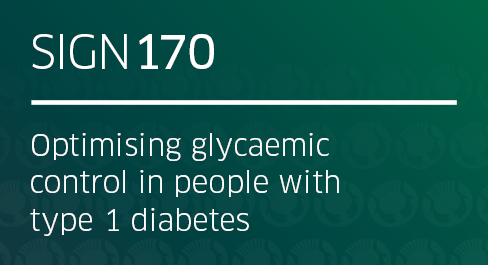Optimising glycaemic control in people with type 1 diabetes
Optimal glycaemic control (HbA1c <58 mmol/mol or >70% time in range) improves the short-, medium- and long-term outcomes of patients with type 1 diabetes by reducing the risk of chronic complications. Scotland fares poorly in regards to optimal glycaemic control, compared with other developed countries, with only 25% of patients with type 1 diabetes achieving optimal glycaemic control with significant regional variations across NHS boards.
SIGN has developed a decision-support toolkit, which can be used on a desktop browser or mobile app, which helps healthcare professionals to support people with type 1 diabetes to improve their blood glucose control. The toolkit prioritises five factors which influence the ability to manage glucose control:
- Environmental and social factors (including the social determinants of health and factors which may act as barriers to achieving good glucose control)
- Structured education
- Psychological and behavioural interventions (including approaches to addressing hypoglycaemia unawareness, eating disorders, depression and anxiety)
- Glucose-lowering and glucose-monitoring technologies (including continuous glucose monitoring and insulin pumps)
- Glucose metrics (including glycated haemoglobin (HbA1c) and Ambulatory Glucose Profile)
This toolkit will be of interest to healthcare professionals in primary and secondary care involved in the care of individuals with type 1 diabetes, including general practitioners (GPs), diabetes physicians, nurses, paediatricians, clinical psychologists and pharmacists.
It will also be of interest to:
- people living with type 1 diabetes, their family and carers
- supportive organisations in the voluntary sector
- policy makers.
How this toolkit was developed
This toolkit was developed by SIGN using a method which involves adapting existing recommendations in this area. We identified, selected and adapted recommendations for optimising glycaemic control in people with type 1 diabetes from existing quality-appraised published guidance. By bringing these together, and adding further resources to support implementation, it provides a focused information resource available at the point of care for healthcare professionals supporting people with type 1 diabetes.
![]() Current < 3 years
Current < 3 years
